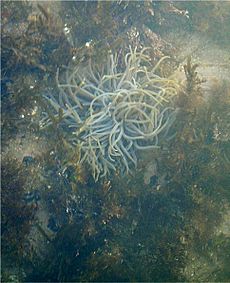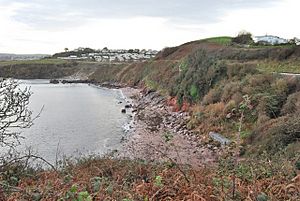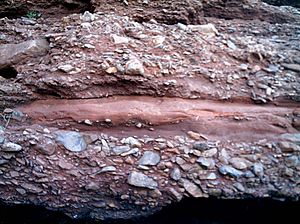Saltern Cove facts for kids
Saltern Cove is a beautiful beach in Devon, England. It is located on the coast of Tor Bay, just south of Paignton. This area is so special that it's called a Site of Special Scientific Interest. It's also part of a group of beaches known as "Three Beaches."
Contents
Amazing Plants and Animals

Saltern Cove has a rocky coastline. This means it's home to many different plants and animals. These creatures live in the area between the high and low tide marks. This area is called the intertidal zone.
Seaweeds and Other Plants
Along the lower parts of the shore, you can find brown seaweeds. These include Flat wrack (Fucus spiralis) and Knotted wrack (Ascophyllum nodosum). Look closely in the rock pools and cracks. You might see many types of algae. One common red seaweed is Corallina officinalis.
Animals of the Shore
Many animals also live here. You can spot the Snakelocks anemone (Anemonia viridis). There are also Spotted goby fish (Gobius ruthensparri). Tiny snails called Periwinkles (Littorina species) crawl on the rocks. You might even find a Squat lobster (Galathea strigosa).
Life in the Sand
When the tide is low, sandy areas appear between the rocks. These sandy spots have their own special animals. You might see Common starfish (Asterias rubens). There are also animals that burrow into the sand. These include the Razor shell (Ensis arcuata) and the Thin tellin (Tellina fabula). Another interesting creature is the Sea potato (Echinocardium cordatum).
The Story of the Rocks

The cliffs at Saltern Cove show many layers of rock. These rocks tell a long story about Earth's past. Most of them formed during a time called the Devonian period. This was millions of years ago! Some younger rocks from the Permian period are also on top. These include sandstones and breccias. Breccia is a rock made of sharp, broken pieces.
Different Rock Layers
The rocks here are mostly limestones from the Devonian period. There are also layers of slate and other rocks like dolerite and tuffs. Dolerite is a dark, strong rock. Tuff is a rock made from volcanic ash. You can see thin bands of shale (a soft, layered rock). There are also green tuffs and red limestones with crinoid fossils. Crinoids are ancient sea creatures.
Fossils in the Rocks
Higher up, there are limestones with amazing fossils. Fossils are the remains of ancient life. Here, you can find fossils of corals like Macgeea, Thamnopora, and Alveolites. One special layer of limestone is seven meters thick. It contains the fossil coral Peneckiella salternensis.
Special Rock Formations
At the back of the beach, you can see these rock types again. They sometimes have lenses of tuff and pale green bands. On the northeast side of the cove, there's a special rock layer. It's called the Saltern Cove Goniatite Band. Goniatites are ancient sea creatures, like squids, that lived in shells. Scientists have found tiny fossils called conodonts in the rocks around this band. These tiny fossils help scientists understand how the rocks formed. They show that the Goniatite Bed might have slid into place a long time ago. About eight meters above the Goniatite Band, there's a thick layer of conglomerate. This rock has large pieces, up to 50 centimeters across! It also contains small pieces of limestone with more conodont fossils.
Protecting Saltern Cove
Saltern Cove is a very popular spot. It's located between two big tourist beaches, Goodrington and Broadsands. Because of this, the cove faces some challenges. Many people enjoy exploring the rockpools and collecting things. However, too much collecting can harm the plants and animals that live there. Scientists believe that the number of different animal species at Saltern Cove has gone down over the last 25 years. This shows how important it is to protect this special place. We need to make sure its amazing wildlife can thrive for future generations.




